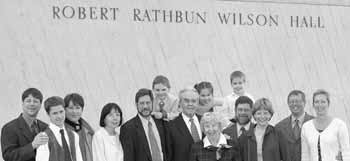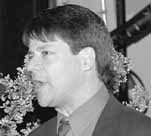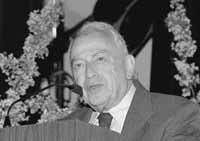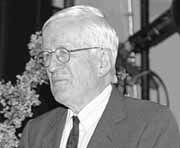 |
|
Wilson by Mike Perricone
The description "larger than life" sometimes fits only the public part of a life. But Robert Rathbun Wilson--physicist, environmentalist, sculptor, human rights activist, pioneering accelerator builder-- was also larger than life as a private person, in the testimony of an unimpeachable source: his youngest son, Rand, whose hero was always a cowboy.
"My dad was a man of the true west. It was high noon, and he was in Dodge City to make things right," Rand continued. "The last few years, I've found myself very affected by the passing of some of the great movie cowboys--Gene Autry, Roy Rogers, and my personal favorite, the Lone Ranger. I realized why they were so special--because I knew I had grown up with a real cowboy hero. When the Lone Ranger rode off at the end of an episode, someone always asked, 'Who was that masked man?'But I always knew. He was my dad." Robert Rathbun Wilson, who died January 16 at 85 following a long illness, had requested burial at the Pioneer Cemetery, where the last documented burial took place in 1851. The U.S. Department of Energy granted Wilson's request, and the Wilson family arranged for a small, private ceremony. Wilson's sons Daniel and Jonathan also attended with their families, including Wilson's four grandchildren. Pioneer Cemetery includes the grave of General Thompson Mead, a veteran of the War of 1812, who established a homestead in Batavia, Illinois. The cemetery became part of the Fermilab site when the federal government acquired the land for the National Accelerator Laboratory (as it was then called) from the state of Illinois in 1967. It was at that time, before a single building had been put up on the land that had formerly been cornfield, that Wilson made his most critical contributions to what would become the world's forefront facility in high-energy physics research, according to Ned Goldwasser.
"Bob was a statesman of immense courage," Goldwasser continued. "He persuaded others that this laboratory was possible, and then he made it possible." Goldwasser described Wilson as a man of many and varied talents, and the speakers at the memorial service paid tribute to that breadth of character from the Ramsey Auditorium stage, framed by prairie flowers drawn wholly from the lab's site. Deputy director Ken Stanfield noted that more than most institutions, "Fermilab remains the creation of just one man." He saw Wilson's presence in the way things are done every day at the place that is "still Robert Wilson's laboratory."
But Ramsey concluded: "He was a very close personal friend and I miss him greatly." While normally a taciturn man, Wilson became quite voluble during one of his favorite activities: riding a horse. The director who had grown up a Wyoming cowboy often started his day viewing the lab from horseback, accompanied by assistant director J. Ritchie Orr, who had not grown up on horseback. "Bob would be galloping along, talking, looking here and pointing there," Orr recalled. "He was one of the great horseman of all time. Meanwhile, I was trying to keep up, and hanging on with both hands." Former Fermilab director Leon Lederman, in videotaped remarks, said Wilson had modeled the lab after the great laboratories of Europe, including the fabled island laboratory of Tyco Brahe. Lederman referred to the current-day budget difficulties in the field when he asked, "Where is Bob Wilson now when high-energy physics really needs him?"
Mau, chief of accelerator operations with 30 years of service, spoke of himself as representing "the common employee, the average worker bee" at the memorial. But Mau spoke with uncommon elegance as he led an imaginary tour through the site, past the Wilson sculpture Broken Symmetry at the west entrance, along the road that winds through the woods because Wilson didn't want some special old trees cut down, past the restored prairie lands, the ponds, the pi-shaped power poles, the array of birdlife from blue herons to geese, arriving at the twin-towered vision of Wilson Hall. "He somehow convinced the best minds to move to the cornfields of Illinois," Mau said. "Bob taught us all to work together to achieve more than any of us could by ourselves. No one in the hierarchy was beyond the reach of the average employee. There are 300 PhD's at the lab but nobody is called 'Doctor.'He gave us jobs that fed our families and fed our creativity. You can wander the site picking raspberries and mulberries for lunch." Mau said he represented the people who were touched by Robert Wilson and continue to be touched by him through the lab, and he concluded by addressing the Wilson sons directly. "With all due respect to our current managers," Mau said, "we still think of your dad as The Boss." |
| last modified 5/12/2000 email Fermilab |
FRLsDFx9eyfrPXgV

 "My dad could ride and rope, and he had the unshakable moral code of a cowboy," Rand Wilson said at the memorial service for Fermilab's founding director, whose ashes were interred April 28 in a private ceremony at the Pioneer Cemetery on the lab site.
"My dad could ride and rope, and he had the unshakable moral code of a cowboy," Rand Wilson said at the memorial service for Fermilab's founding director, whose ashes were interred April 28 in a private ceremony at the Pioneer Cemetery on the lab site.
 "Bob Wilson's greatest impact came in the formative years, when the laboratory was only a dream and then a twinkle in a few eyes," said Goldwasser, the lab's first deputy director, in his tribute during the Ramsey Auditorium memorial service.
"Bob Wilson's greatest impact came in the formative years, when the laboratory was only a dream and then a twinkle in a few eyes," said Goldwasser, the lab's first deputy director, in his tribute during the Ramsey Auditorium memorial service.
 Norman Ramsey, founding president of Universities Research Association, Inc., recalled that Wilson was designated Employee No. 1 and then determined that Ramsey should be Employee No. 0, "which led to a little confusion at the gate." He lauded Wilson's attention to detail in all aspects of the lab, including the budget, and admitted that Wilson's manner could be "sometimes a little tough."
Norman Ramsey, founding president of Universities Research Association, Inc., recalled that Wilson was designated Employee No. 1 and then determined that Ramsey should be Employee No. 0, "which led to a little confusion at the gate." He lauded Wilson's attention to detail in all aspects of the lab, including the budget, and admitted that Wilson's manner could be "sometimes a little tough."
 Bob Mau had the answer: Wilson exists in every fiber of the lab.
Bob Mau had the answer: Wilson exists in every fiber of the lab.